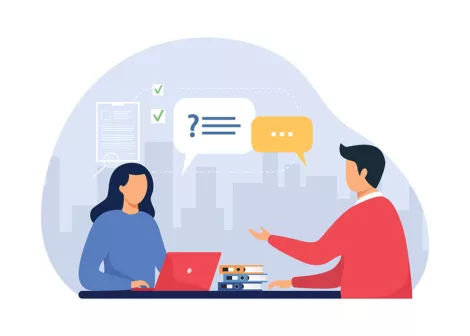Conducting qualitative research is a difficult task. You must be well-prepared for qualitative interviews and know how to conduct them to extract as much information as possible. In this article, we advise you on how to get the most out of this exercise.
Contact IntoTheMinds for your qualitative projects
There are several phases to any semi-structured qualitative interview. In addition to the phases set out in the interview guide itself, we can distinguish 3 phases:
- The beginning of the interview, when the interviewer and interviewee meet for the first time.
- The body of the interview itself, during which the questions at the heart of the interview are asked
- The end of the interview, when interviewer and interviewee part company.
Phase 1: initiating the qualitative interview and breaking the ice
As in any context where two people meet for the first time, it can sometimes be difficult to find the right words to “break the ice.” Getting the conversation off to a good start is essential, as this will determine what happens next. Trust is often established (or not) between interviewer and interviewee in the first few minutes. As a result, it also determines the length of the interview and the amount of information you can extract.
Here are some ice-breaking strategies and phrases.
Find out about the interviewee before the interview
Before the qualitative interview, take the time to find out about the person with whom you’ll interact. Find out what they have in common (if possible) or at least some salient points that can serve as a starting point for discussion.
- I saw on your LinkedIn profile that … It’s a coincidence, but I, too …
- I understand that you know [X]. She’s also a relation of mine.
- How did you come to know them?
- I took the liberty of consulting your company’s website before this interview. I saw that …. and found it very interesting.
Value the interviewee
Human beings love nothing more than to be flattered. Use this weakness to your advantage to get the qualitative interview off to a good start. This technique works particularly well in B2B interviews.
- I’m delighted to have you here. Thank you for accepting the invitation. I’m completely new to [X], so please don’t hesitate to give me detailed explanations.
- As I’m a complete novice in this field, please explain …
- It’s a pleasure to meet you. I understand you have a great deal of experience in [X]. This is going to be a really interesting interview.
Phase 2: How can the maximum amount of information be extracted during the qualitative interview?
Follow-up with the interviewee
Follow-up techniques are THE cornerstone of any good interview. An all-too-common mistake is to be content with what the interviewee has said in the first instance. Your job is to get your interviewee talking. So, it would be best to go deeper into what they have said until there’s nothing left to extract.
Here are a few examples of follow-up phrases:
- You said “….”. Can you tell me more?
- What do you mean by …?
- I find your explanation of … particularly interesting. Please tell me more.
- I understand from what you’ve just said that… Is that correct?
- That’s very interesting. How do you explain that …?
- In your opinion, how do you explain that …?
- Does this mean that …?
If you don’t understand, ask questions
Another mistake often made is not to ask what the interviewee is saying. Too often, the interviewer goes through the questions without necessarily trying to understand what the interviewee is saying. The interview guide differs from a list of questions you go through. It’s a basis for guiding a discussion, which, in the end, should be pleasant and enriching. If the person you’re interviewing tells you something you don’t 100% understand, you should ask them to clarify what they’re saying.
Here are a few standard phrases to help you do just that:
- Excuse me in advance if this is a stupid question, but what does…?
- Forgive me, but I’m not sure I’ve understood everything. You said that …
- What do you mean by …?
- Could you return briefly to … I’m still trying to understand.
Valuing speech
In the first part of this article, we talked about valuing the interviewee. This technique also works during the interview. Here are a few examples of how to do it:
- I find this very interesting. Can you elaborate?
- You’re an expert in [field]; how do you analyze…?
- I’m not a specialist in this field, but how would you explain that …?
- Given your expertise, how would you explain that …?
Don’t miss the metaphors
The metaphors with which we sprinkle our sentences are particularly interesting and have deep symbolism. We don’t use them by chance. They convey a meaning that sometimes escapes us at the time. A qualitative interview provides the interviewer with an easy opportunity to bounce back and go deeper.
- You said [metaphor]. What do you mean by that?
- I noticed you used a metaphor: …. What does it mean?
- Is it important to [metaphor]?
Pay attention to “body language”
Finally, pay attention to the “body language” of the person you’re interviewing. It can be observed even in the qualitative remote interviews that have become the norm since the Covid crisis.
| Body language | Meaning | What to do ? |
| Change the subject | They are bored | Changez de sujet |
| Answers are given with an energetic/cheerful intonation | Wants to say more | Follow-up ! |
Phase 3: The end of the interview, an important moment not to be neglected
The end of the qualitative interview is a moment that is often neglected, even though it can add a great deal of value. Announcing the end of the interview sometimes marks a new beginning. So, continue recording the interview until your interviewee has left. You risk missing out on the last bit of information.
Here are a few ways of announcing the end of the interview while maximizing the chances of “restarting” it:
- It was really interesting. I learned a lot. I never would have thought…
- Thank you for your time. I’ve discovered a whole new subject. How can I find out more?
Also, remember that the end of the interview is a good time to use the “snowball effect” for your recruitment.
Posted in Marketing.


